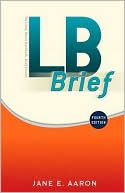LB Brief
Search in google:
LB Brief offers the authority and currency of its best-selling parent, The Little, Brown Handbook, in two briefer, spiral-bound formats (one with tabs and one without tabs) at affordable prices.As in its previous edition, LB Brief provides students of varying skills and interests with clear, reliable, and accessible explanations of handbook basics–the writing process, grammar and usage, and research writing. The Fourth Edition builds on the handbook’s usefulness with four main emphases: (1) reading and writing across the curriculum, including an expanded chapter on academic writing, showing students how to write in response to texts, and more coverage of argument, with information on how to handle opposing views and strengthen an ethical appeal; (2) research writing, including expanded discussions on how to find and evaluate print and Web sources, and a new research-paper-in-progress; (3) up-to-date documentation guidelines, including the most recent revisions to MLA and APA documentation styles, with numerous models of new media in each style and new annotated sample sources; (4) more writing process instruction, including a new student work-in-progress and new discussions of voice in writing.
Preface for StudentsPreface for InstructorsPart 1: Writing Process1 The Writing Situationa Analysisb Subjectc Purposed Audience2 Inventiona Journal keepingb Observingc Freewritingd Brainstorminge Drawingf Asking questions3 Thesis and Organizationa Thesis statementb Organizationsample Essay4 Draftinga Startingb Maintaining momentumc Sample first draft5 Revising and Editinga Revising the whole essayb Sample revisionc Editingd Formatting; proofreadinge sample Final Draftf Collaboratingg Preparing a writing portfolio6 Paragraphsa Unity around a central ideab Coherencec Developmentd Introductions; conclusionse Linking paragraphs7 Document Designa Academic papersb Principles of designc Elements of designd Illustrationse The Webf Readers with vision lossPart 2: Writing in and out of college8 Critical Thinking and Readinga Critical reading techniquesb Critical responsec Critically viewing images9 Academic Writinga Responding to textsb Purposec Audienced Structure and contente Languagef sample critical response10 Writing Argumentsa Elements of argumentb Reasonablenessc Organizationd sample argument11 Reading and Writing About Literaturea Writing while readingb Critical readingc sample literary analysis12 Taking Essay Examsa Preparingb Planningc Draftingd Rereadinge sample Essay Exams13 Public Writinga Business letters and résuméssample letter and résumésb Memossample Memoc E-mailsample e-mail messaged Community worksample newsletter14 Making Oral Presentationsa Purpose and audienceb Organizationc Deliverysample powerpoint slidesPart 3: Clarity and Style15 Emphasisa Subjects and verbsb Sentence beginnings and endingsc Coordinationd Subordination16 Parallelisma With and, but, or, nor, yetb With both . . . and, etc.c In comparisonsd In lists, headings, outlines17 Variety and Detailsa Sentence lengthb Sentence structurec Details18 Appropriate and Exact Wordsa Appropriate wordsb Exact words19 Completenessa Compoundsb Needed words20 Concisenessa Focusing on subject and verbb Cutting empty wordsc Cutting repetitiond Tightening clauses and phrasese Revising there is or it isf Combining sentencesg Avoiding jargonPart 4: Sentence Parts and PatternsBasic Grammar21 Parts of Speech22 The Sentence23 Phrases and Subordinate Clauses24 Sentence TypesVerbs25 Formsa Irregular verbsb Sit/set; lie/lay; rise/raisec -s and -ed formsd Helping verbse Verb + gerund or infinitivef Verb + particle26 Tensea Present tense: singb Perfect tenses: have/had/will have sungc Progressive tenses: is/was/will be singingd Consistencye Sequence27 Mooda Subjunctive: I wish I wereb Consistency28 Voicea Active vs. passiveb Consistency29 Subject-Verb Agreementa -s and -es endingsb Intervening wordsc Subjects with andd Subjects with or or nore Everyone and other indefinite pronounsf Team and other collective nounsg Who, which, thath News and other singular nouns ending in -si Verb preceding subjectj Is, are, and other linking verbsk Titles; words being definedPronouns30 Casea She and I vs. her and meb It was she vs. It was herc Who vs. whomd Other constructions31 Pronoun-Antecedent Agreementa Antecedents with andb Antecedents with or or norc Everyone, person, and other indefinite wordsd Team and other collective nouns32 Pronoun Referencea Clear referenceb Close referencec Specific referenced Appropriate youe ConsistencyModifiers33 Adjectives and Adverbsa Adjective vs. adverbb Adjective with linking verb: felt badc Comparisonsd Double negativese Participles: boring vs. boredf A, an, the; other determiners34 Misplaced and Dangling Modifiersa Misplaced modifiersb Dangling modifiersSentence Faults35 Sentence Fragmentsa Testsb Revisionc Acceptable fragments36 Comma Splices and Fused Sentencesa Main clauses without and, but, etc.b Main clauses with however, for example, etc.37 Mixed Sentencesa Mixed meaningb Tangled grammarc Repeated subjects and other partsPart 5: Punctuation38 End Punctuationa Periodb Question markc Exclamation point39 Commaa Main clauses with and, but, etc.b Introductory elementsc Nonessential elementsd Items in seriese Two or more adjectivesf Dates, addresses, etc.g With quotationsh Misuses40 Semicolona Main clauses without and, but, etc.b Main clauses with however, for example, etc.c Main clauses or series items with commasd Misuses41 Colona Concluding explanation, series, etc.b Salutation; title and subtitle; timec Misuses42 Apostrophea Possessionb Misusesc Contractionsd Plural abbreviations, etc.43 Quotation Marksa Direct quotationsb Within a quotationc Titles of worksd Words used in a special sensee Misusesf With other punctuation44 Other Marksa Dash or dashesb Parenthesesc Ellipsis markd Bracketse SlashPart 6: Spelling and Mechanics45 Spelling46 Hyphen47 Capital Letters48 Italics or Underlining49 Abbreviations50 NumbersPart 7: Research and Documentation51 Research Strategya Planningb Research journalc Subject and questiond Goals for sourcese Working, annotated bibliography52 Finding Sourcesa Your library's Web siteb Searching electronicallyc Reference worksd Bookse Periodicalsf The Webg Other online sourcesh Government publicationsi Images, audio, and videoj Your own sources53 Working with Sourcesa Evaluating sourcesb Synthesizing sourcesc Gathering informationd Using summary, paraphrase, quotatione Integrating sources54 Avoiding Plagiarism and Documenting Sourcesa Plagiarism and the Internetb What not to acknowledgec What must be acknowledgedd Online sourcese Documenting sources55 Writing the Papera Focusing and organizingb Drafting; revising; formatting56 MLA Documentation and Formata Parenthetical text citationsb List of works citedc Format of paperd sample MLA Paper57 APA Documentation and Formata Parenthetical text citationsb List of referencesc Format of paperd sample APA paperGlossary of UsageAnswers to Selected ExercisesIndex








